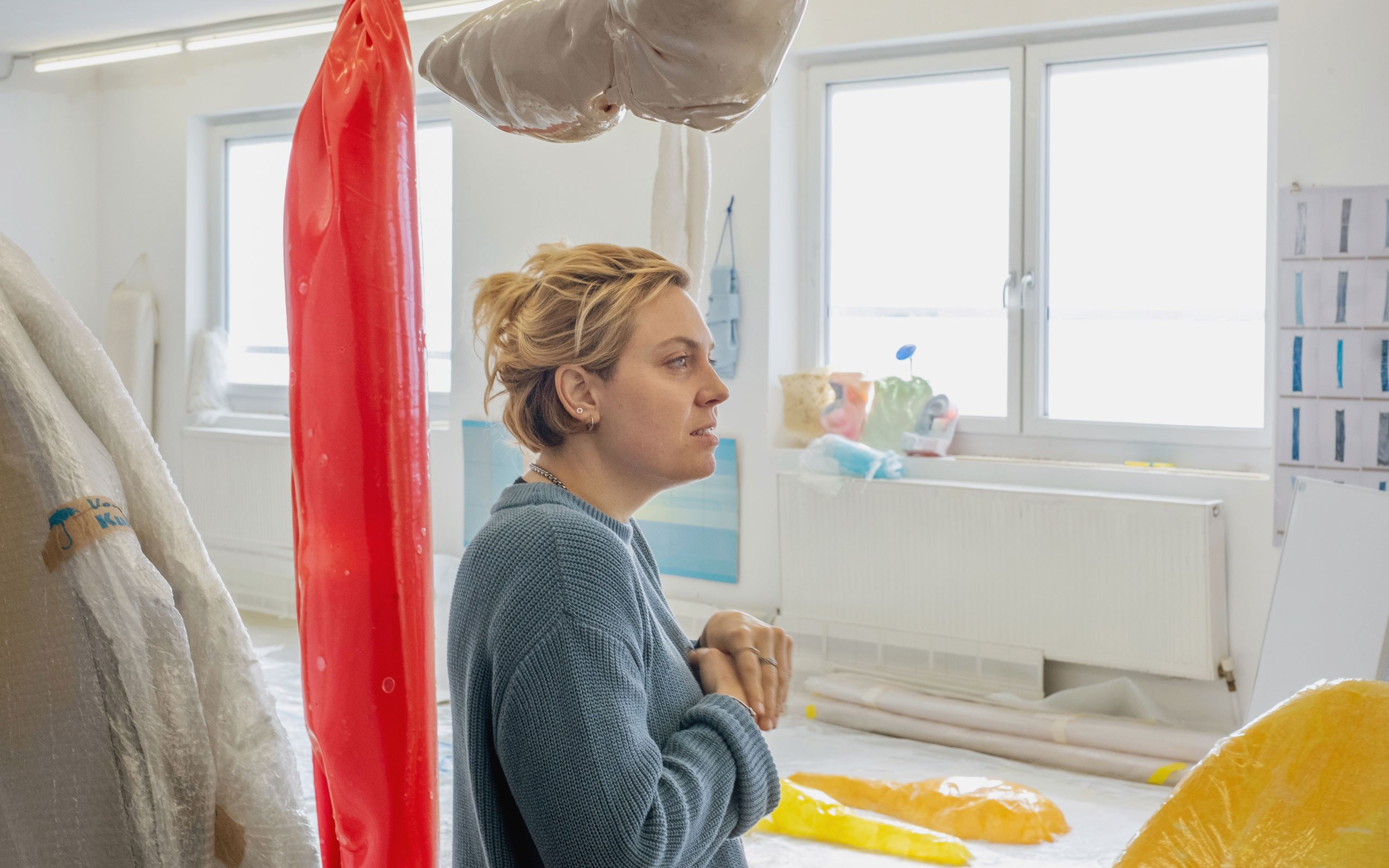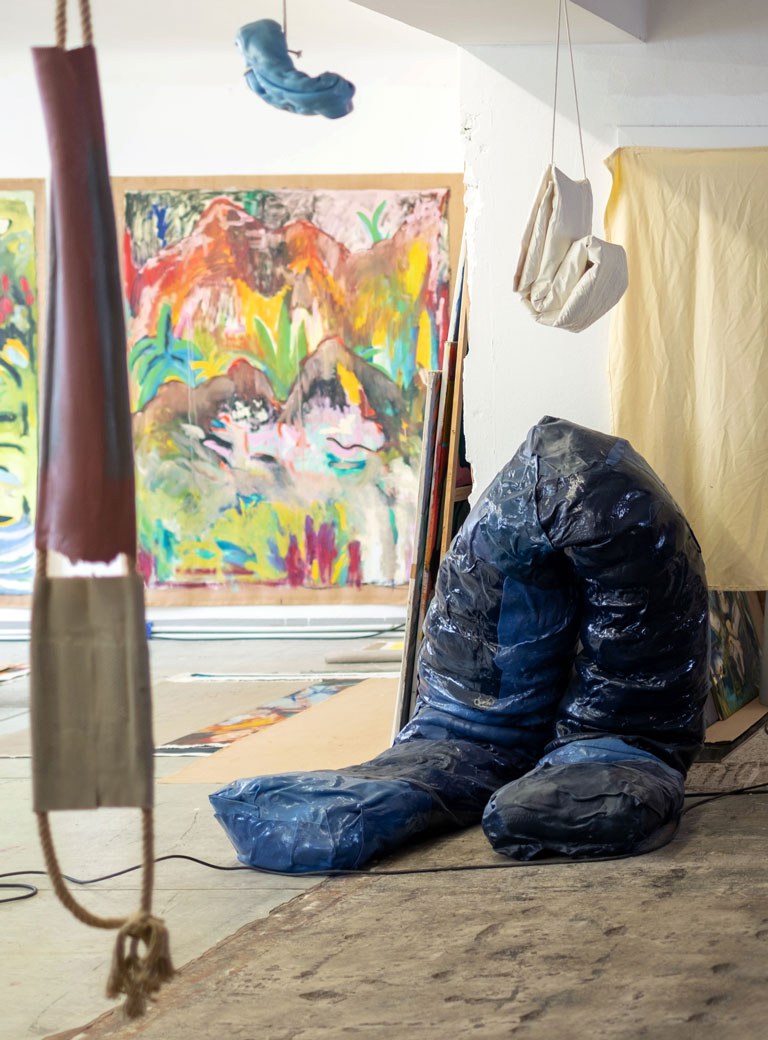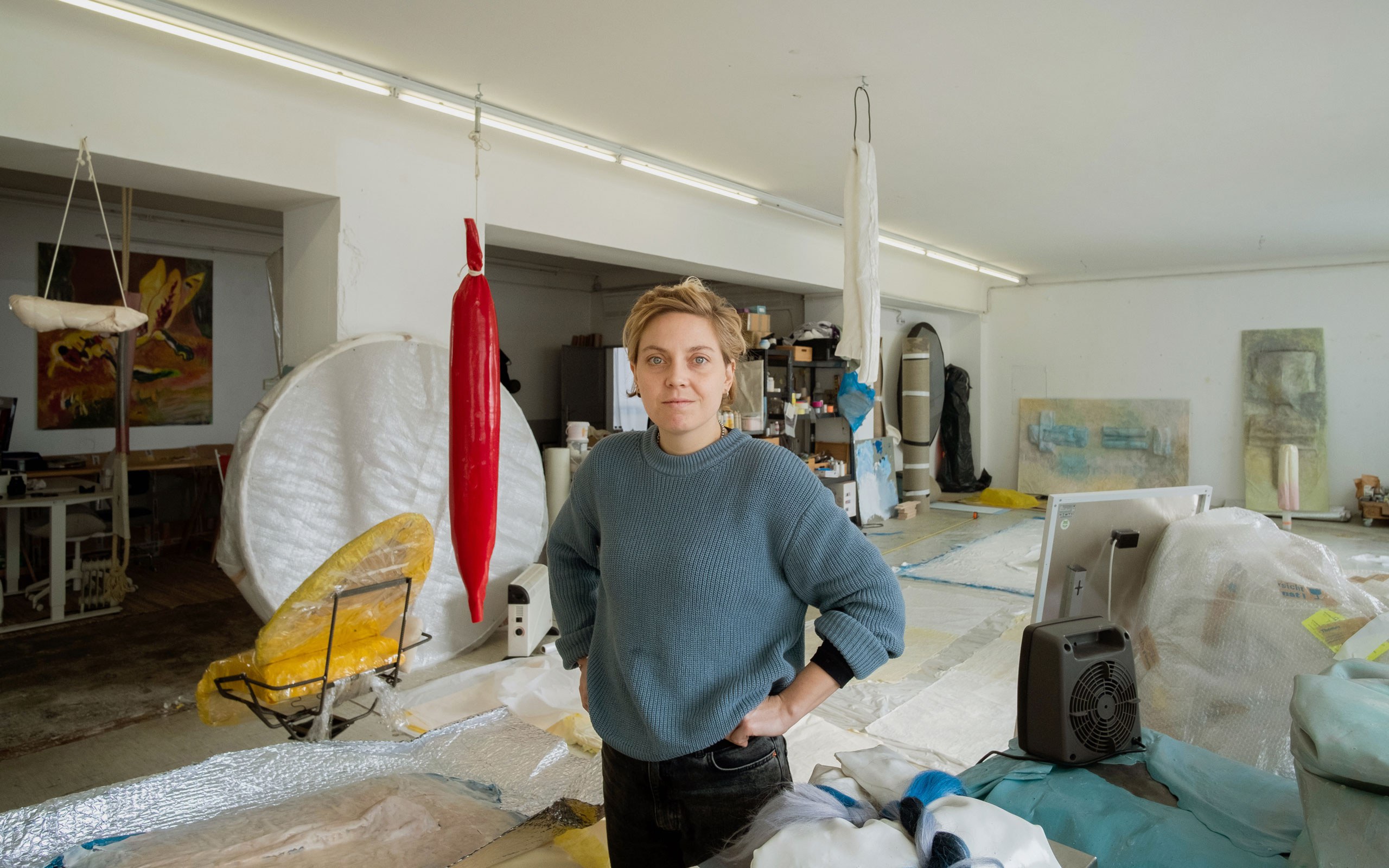By means of complex processes, the Viennese artist Julia Haugeneder creates folded objects possessing an impressive formal language and which demonstrate an experimental approach to material and space. She produces the material for her artworks herself, and the folding is an integral movement that creates order and brings previously remote points into contact with one another. By means of this dialogical process, the artist seeks to interweave aspects of art history and current contemporary phenomena.
Julia, your path to art was anything but straightforward …
That’s true. It has taken me a long time to admit to myself that I could do it. It really is a classic case of not coming from a background where art played any role. I did paint as a teenager, but I didn’t take it seriously at all. Then I actually studied art history although from a position of faint-heartedness because I just didn’t have the courage to apply for admission to an actual art course. However, it transpired that I wasn’t very happy studying art history and really only completed the course so as not to leave things at a loose end.
When did you decide to study art?
Having realized that art history didn’t quite suit me, I applied to the Academy of Fine Arts in Vienna and was finally accepted on the third attempt. I studied the philosophy of film at the same time and began my dissertation. So, there was a time when I was following dual tracks, the theoretical field and working towards a small university career and I quickly realized that I lacked both the tenacity and consistency for a classic academic career and while recognizing the incompatibility, I found I derived a great deal of joy and pleasure from working in the studio.
How was your initial time at the academy, were you able to settle in quickly?
It took me a long time to become accustomed to this kind of working. I started with video art but soon discovered it was difficult to work without material. I almost gave up, but I visited the academy workshops to try out techniques and materials with which I was unfamiliar, and I found it really cool to work with these methods and materials; it seemed it was only after three years that I really began working in the printmaking class.


In the meantime, folding objects has become an important part of your artistic practice. How did you discover this technique of folding?
For me, folding is a vehicle to create sculptures in an economical way. I started with very small works, actually based on the folding game Heaven and Hell; this idea of moving from the two-dimensional to the three-dimensional was very enriching. The folding techniques we learn from an early age are very conventional ... So, I just practiced that and realized, ah funny, as soon as you fold, you perform a kind of tidying up. We fold to put things in order ranging from clothes to toilet paper. So, there’s this idea of transforming something big into a compact form and doing it according to a very organized system. This method has proven able to create objects in various sizes, shapes, and colors that I would like to actually exist.
What defines the material, what does it allow you to do?
Basically, it consists of a very thin rubber skin that I produce myself. I don’t start by buying a material, like canvas, rather my first step is to produce this material in all possible sizes, and because it is just a rubber skin that you can lay over everything, you can turn this two-dimensional surface into a three-dimensional object. I still find this a very good technique although the sculptures are light, they are relatively large, I can freely determine the color and the haptic quality… I found all this very accommodating.
How can we picture your working process?
It involves often long research into material and phenomena of time, and in the working process it sometimes becomes very far removed from that. I also write texts, and what I say is very concrete, but sculptures open up to other themes. I start small and then it expands thematically, especially when I’m working.
Do you always work with a theme?
Yes, and actually also in series; I don’t think I’ve ever done a singular work; it is easier for me not to expect so much from one object. That does not mean that I will show them all ... Sometimes what I end up with is relatively far removed from how I started. For example, this red object No Lips from 2023, which was about taking this very typical lipstick shape, which has been marketed since the 1950s, and working with it to make an object that has this corporeality and these lips in some way.



In your collaboration in the piece Stroke all the colours out of the sky – a portrayal of the artist’s process (2023) with the Irish artist and choreographer Asher O'Gorman, you could be seen on stage producing your work. What was that like for you?
Asher had asked me a year and a half before the production if I wanted to participate. At that point it was still completely open as to what it would involve. I hadn’t even realized then that I was expected to be on stage. (laughs) When I said yes, she said that because of the intensity, what might happen is that afterwards I may no longer want to work with my materials, to which I thought, that’s great, it’s practically like psychoanalysis (laughs). And that motivated to me to participate.
That sounds like an intense time. Did that interrupt your actual artistic practice?
That was indeed the case and at that point one realizes how differently the areas are structured. I usually work on three exhibitions at the same time, which are created side by side, and then suddenly this monolith appears ... and I realized that you can’t work on both together. It’s an either this one or that one decision, like with shooting a movie, it just swallows you up and doesn’t afford you the ability to work in part on the preparation of an exhibition, the two disciplines are quite incompatible.
So, you wouldn’t do it again?
No. I’m not an on-stage person. It was cool to look into a different area, but I don’t want to be seen. I want my work to be exhibited. Nevertheless, I felt it was a privilege that someone would be in the studio with me so intensively and for so long.



You associate fairly large themes such as capitalism with folding, as in the exhibition Abschied. Oder eine Person und ein Esel zusammen Wissen mehr als eine Person alleine (Farewell. Or a person and a donkey together know more than one person alone) (2023).
It is a development of the last year that I have allowed myself to take up more concrete themes. I come from a theory-based research background, and I want to integrate this into my exhibitions, but at the same time I want to maintain a formal openness in the works, i.e., that the sculptures are not simply an illustration of the reflections, but that there are these two aspects. In itself, it is about collectivity, that we are always in relation to everything, so we are never detached and everything we are surrounded by has not been produced by an individual, similarly in the visual arts, because the materials themselves, the ones we work with, were created collectively, this applies in my works to a certain extent. Sometimes you realize, wow, I'm interwoven into so much and at the same time, and that was what I found interesting about this exhibition.
How did you actually come up with this very unusual title?
A cab driver once mentioned it to me in the middle of the night while we were looking up the route together (laughs). He said that most people are quite offended when he says that, and they immediately ask which one of us is the donkey? And I actually thought it was quite cool because he went on to say that he was doing a study around the saying.
Are you still in contact with him?
No, unfortunately not. He really has no idea what he's unleashed (laughs); it’s actually a real shame, but I didn’t realize at the time that it was going to be such a thing. I kept thinking about this sentence for weeks and then I realized it is actually great, I want to work with it.
Do you always work towards exhibition contexts?
Yes, and there are pros and cons ... I recently postponed some exhibitions because I needed a gap where I wasn’t producing for an exhibition, but making things that I didn’t have to hope would be exhibitable. And so, I started making completely different sculptures, which are also made of a different material. I underestimated that I needed this freedom to be able to develop something. Even for bigger leaps, to get somewhere else, I mustn’t have the feeling that I have to exhibit it now.
Do you need the exhibition space to get into a work mode at all?
Without a place, or a concrete context, it’s almost impossible ... I see the space, and then it’s like a mental 3D program and how an exhibition is put together. I don’t make any sketches or room plans; I build individual parts in the studio and then I bring them into the space, and they are assembled. Sometimes a work doesn’t fit because the dimensions aren’t correct, but I think it’s all good somehow since it’s already specific for this space, but it’s very much based on pi times thumbs and a Lego system (laughs).

Collaboration is important to you. What does that mean for you concretely?
After two years of exhibiting quite a lot, I realized that I like working with other people, but not so much in a collective that is stable in its composition, but simply in principle. Fortunately, I’m surrounded by a lot of interesting people with whom I also enjoy working, which is why I made the decision to only exhibit together with other people and no longer alone. And that makes me really happy.
A courageous step …
I’m thrilled with this decision because I realize that it inspires me and it’s much more fun to go to the studio when I'm also in contact with people. It also becomes more complex and cooler because you can only see certain things so far and when someone talks to you, you often come up with different things. I think the exhibitions simply get better that way. I think I adopted the idea of solo exhibitions too much as the norm and didn’t even ask myself whether it was something I wanted.
You have the ambition to make things tangible …
It has something to do with self-confidence and also getting older ... Having the ease to take even simple things seriously and daring to say them, including one’s own political stances. At the academy, I forgot a bit about putting my attitudes into my work, as if I had decoupled them, and I have to learn to dare to be very clear in my formulations and to expect my work to take an attitude; that can change over the years, but it’s very important to me now.
It sounds like a constant process of reflection on your artistic development.
I would find anything else quite tragic. It’s not a judgment on the work of others in general. I think a lot of artists who stick to their work like that are great, and you can see that they develop something within a formal language, it’s just not conceivable for me because otherwise I wouldn’t feel like going to the studio anymore. If it’s too narrow, where I move, then it becomes too predictable for me.


To what degree is it easy for you to relinquish your works knowing that they are to be sold?
I don’t find it difficult, especially as it enables me to pay my rent. When I sold my first works, it was like an act of alchemy for me, that what I do that isn’t terribly laborious turns into money (laughs). And I actually don’t want them; I wouldn’t even know where to store them ... I keep very few things.
Your works have certainly grown, will they get any bigger?
No, I want to get smaller again. And I intend to make very small things because I find that charming. We all take up too much space and material, smaller appeals to me.
You live and work in Vienna, what does the city offer you?
I love being away, but Vienna is a great home base, and I appreciate that there is a welfare state in the remaining forms, like Wiener Wohnen. It’s very pleasant to live here, especially as an artist, and not to worry too much, but I would like to see more subsidized studios developed.
And where do you see yourself in ten years? Will you still be an artist then?
I don’t know (laughs). I also think it’s really good not to know. Like the vast majority of people, I regularly ask myself whether I ought to be doing something else. From exhibition to exhibition, however, I think that everything is actually great and I’m grateful that I’m allowed to do this and that I don’t have to work a nine to five job. And so, it’s great that I only have time for art. But it could go in any direction ...

Your current exhibition go to work on an egg (2024) in cooperation with Magdalena Kreinecker, Matteo Sanders, and werkbuero at the Neue Galerie Graz is all about the egg. What was your starting point?
Our starting point was the relationship between labor, which is a basis for capitalism, in relation to the state regulation of food and the marketing of it. We weren’t interested in making another exhibition about eggs, but about objects that have arisen around the egg in capitalism. And during my research, I came across the “go to work on an egg” advertising slogan for the United Kingdom’s Egg Marketing Board. Even after the end of the Second World War, eggs continued to be rationed there and in 1953 when eggs became once more available on the free market, the British government launched this expensive advertising campaign which continued throughout the 1960s until it was discontinued in 1971; it was intended to encourage workers to go to their workplaces healthy and nourished.
What else can we look forward to, what projects are you working on?
I will be in Athens on an AiR until the summer. In June, an exhibition opens at the Baden Kunstverein, which I’m really looking forward to because I’m co-organizing it – (c)lick, it will open on June 29. And the next big exhibition will be next year at the Kunstverein Augsburg.

go tow work on an egg, exhibition view, Neue Galerie Graz, 2024, Julia Haugeneder in cooperation with Magdalena Kreinecker, Matteo Sanders and werkbuero,(c)kunst-dokumentation.com

go tow work on an egg, exhibition view, Neue Galerie Graz, 2024, Julia Haugeneder in cooperation with Magdalena Kreinecker, Matteo Sanders and werkbuero,(c)kunst-dokumentation.com

go tow work on an egg, exhibition view, Neue Galerie Graz, 2024, Julia Haugeneder in cooperation with Magdalena Kreinecker, Matteo Sanders and werkbuero,(c)kunst-dokumentation.com
Interview: Marieluise Röttger
Photos: Maximilian Pramatarov






